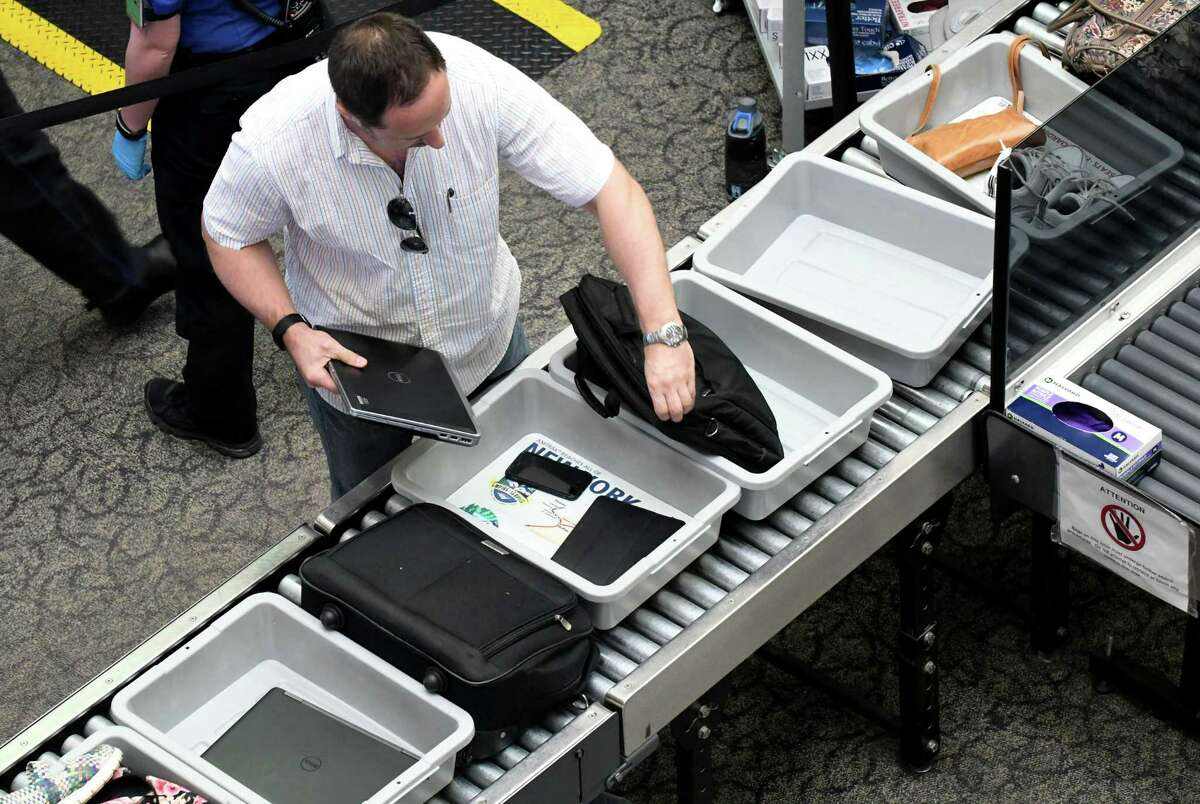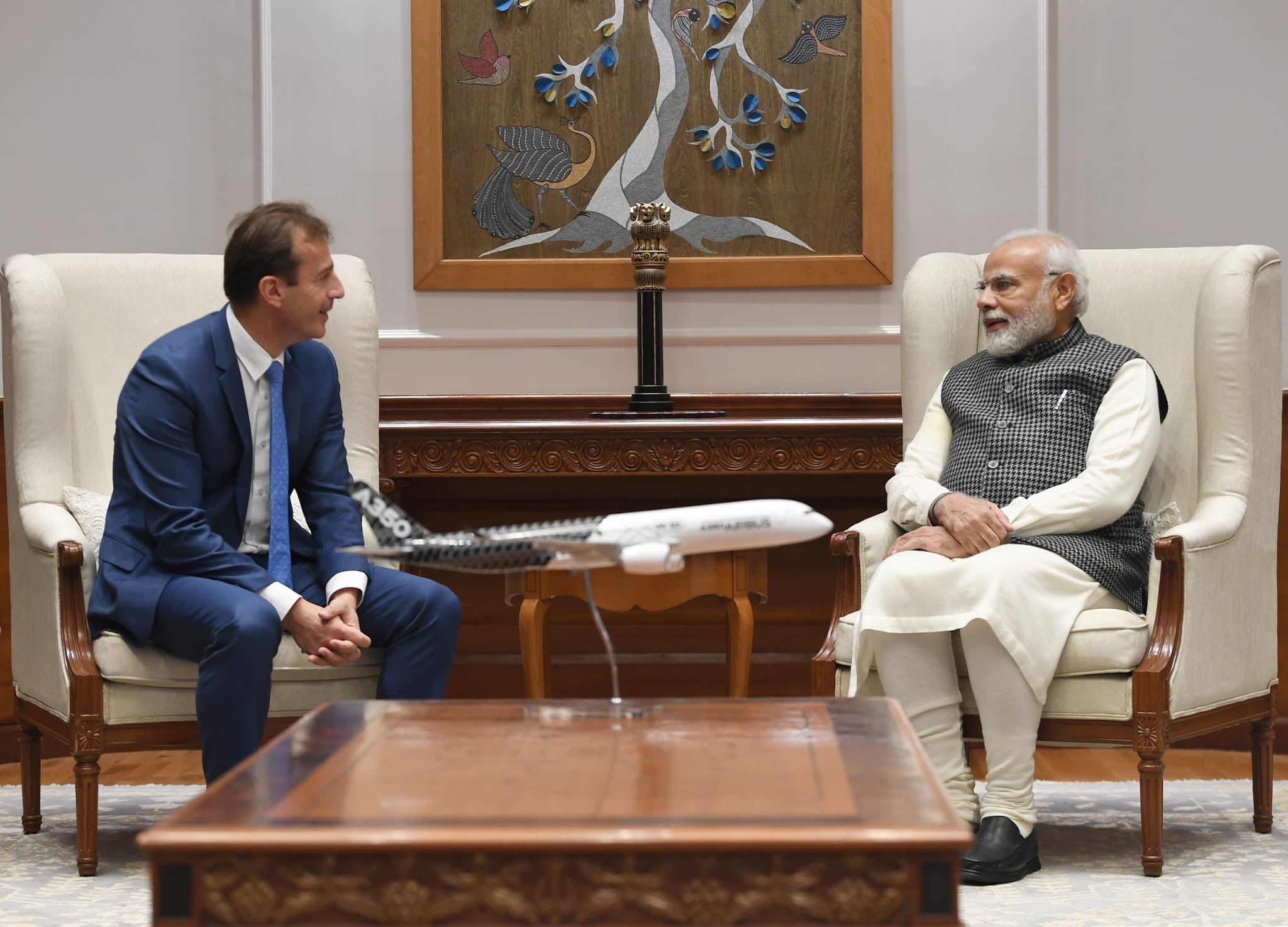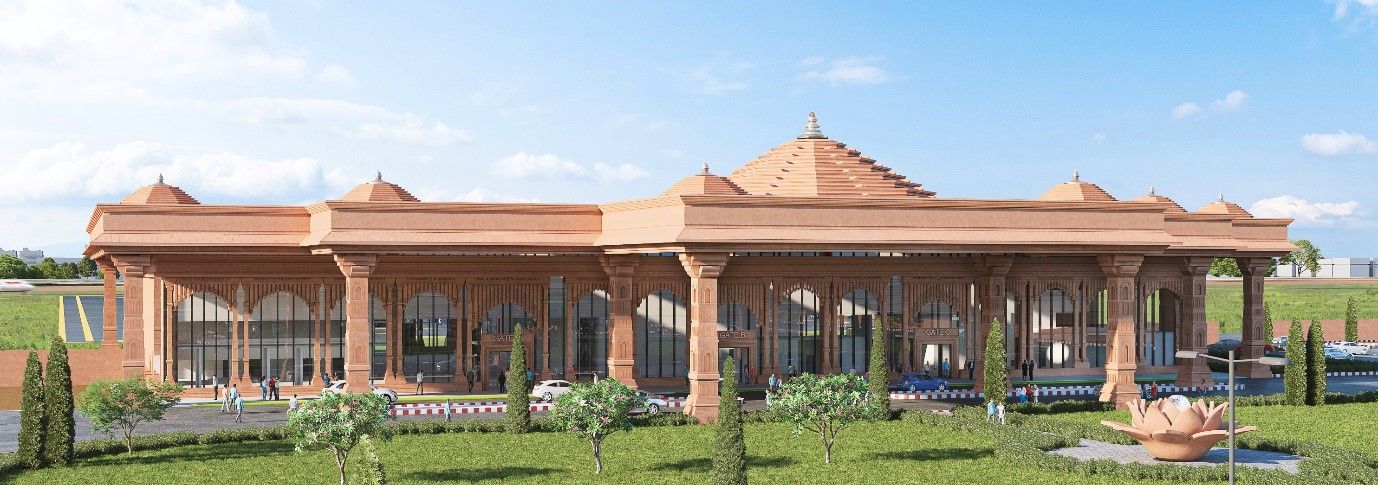Airbus plans to deepen its industrial presence in India, Chief Executive Guillaume Faury said on Wednesday, December 22 after meeting the country's prime minister.
"We will continue to support civil aviation growth and deepen our industrial footprint in India," Faury said on Twitter alongside a photograph of his meeting with India's Prime Minister Narendra Modi.
He did not provide further details. Faury's comments on industrial presence come as India is increasingly involved in the civil supply chain.
https://twitter.com/GuillaumeFaury/status/1605478296409362433
A senior Boeing Co official told ET Infra in September that India had shown resilience during the pandemic and that Boeing and other companies would make increased use of its suppliers.
The meeting between the world's largest civil planemaker and the leader of the world's fastest-growing airline market also coincides with a potentially huge Air India jet purchase, though industry sources said this was not the main focus of the visit.
Airbus plans to deepen its industrial presence in India, Chief Executive Guillaume Faury said
Air India is in the advanced stages of negotiating a major fleet renewal and expansion under new owner Tata Group that industry sources say could involve 250 Airbus jets including 200-210 A320neo-family jets and over three dozen A350s.
Airbus also hopes to secure a new home at Air India for six A350s originally earmarked for Russia's Aeroflot, though it remains unclear whether these are included in the main order.
ALSO READ - Air India jumbo aircraft order to include B737 MAX and B787 Dreamliner
Air India is also close to a deal to buy some 190 Boeing 737 MAX jets and 30 of its B787 Dreamliners as part of the same package potentially close to 500 aircraft, Reuters reported last week. The deal could also involve a handful of larger 777X jets.
After intense talks in the past week, outlines of a package worth tens of billions of dollars are taking shape but the timing of any announcement remains unclear, the sources said. Big-ticket aircraft negotiations typically go down to the wire and can break down at the last minute over contractual details like deposits and inflation clauses.
Airbus declined to comment and Tata Group was not immediately available to comment.
In October, Tata Group and Airbus said they would make the C-295 military transport aircraft in India.
India, among the world's largest defence importers, has been trying to cut its reliance on foreign firms and increase local output. Only state-owned Hindustan Aeronautics Ltd currently makes aircraft, mainly for the armed forces.
(With Inputs from Reuters)
Read next
The Airports Authority of India (AAI) on Wednesday, December 21 said the overall project work of Ayodhya airport is expected to be completed by June 2023. The airport development project is worth INR 242 crore. It includes the construction of a terminal building and the development of airside facilities.
"The new terminal building with a total area of 6,000 sq.m.is being designed to serve 300 passengers during peak hours with an annual handling capacity of 6 lakh passengers," AAI said in a release.
Ayodhya airport to be completed by June 2023
52% of development work has been completed till now and overall project work is expected to be completed by June 2023. This airport will not only put the pilgrimage site on the aviation map but also give a boost to the economic development of the region. Direct air routes to this important religious destination would facilitate seamless and direct connectivity for pilgrims all over the world.
ALSO READ - AAI has begun the construction of Ayodhya airport
The design of the airport will reflect the idea and spirit of Ram Mandir, invoking a sense of spirituality and creating a sense of place for all passengers arriving and departing from the airport... The glass façade of the terminal will be designed to recreate a sense of being in the very palace of Ayodhya.
The roof of the terminal is proposed to be adorned with shikharas, of varying heights to convey a sense of grandeur to the structure. The terminal will have decorative columns displaying important events from Ramayana pictorially. The building will shine aesthetically and functionally, displaying a perfect mix of local architecture with a modern architectural note," AAI said in a statement detailing the upcoming airport's architectural aspects.
Direct air routes to this important religious destination would facilitate seamless and direct connectivity for pilgrims all over the world.
ALSO READ - UP government signs lease agreement with AAI to transfer land for Ayodhya Airport
The Ayodhya airport is among several projects of the Centre and the state government that have been approved for the temple town. Ayodhya Airport is the fifth international airport in Uttar Pradesh (after Lucknow, Varanasi, Kushinagar and Noida).
In 2008, the Ayodhya Airport was handed over by the government of Uttar Pradesh to the Airports Authority of India (AAI) to be developed as a full-fledged airport along with three others (Meerut, Moradabad and Saifai) with the approval of the Uttar Pradesh cabinet. The government of Uttar Pradesh is providing extra land free of cost for further expansion and for the construction of a terminal.
Read next
BCAS to issue norms where electronic devices will be scanned inside the bag only
Radhika Bansal
22 Dec 2022

The long queues of air travellers removing their laptops, mobile phones and chargers from their cabin baggage before screening them could soon become history in India. The aviation security regulator, the Bureau of Civil Aviation Security (BCAS), is expected to issue technical norms within a month which will pave the way for airports to adopt modern equipment to screen bags without removing electronic devices.
“Newer technologies are needed for better security as well as passenger convenience,” BCAS director general Zulfiquar Hasan told The Hindu.
“All airports, including Delhi airport, need to improve the machines deployed for screening of cabin bags. They are lagging behind. Technologies such as dual x-ray, computer tomography and neutron beam technology will eliminate the need for passengers to remove laptops and other electronic devices,” a senior official of the Central Industrial Security Force (CISF), which oversees airport security, told The Hindu on the condition of anonymity.
Over-crowded airports
The call for modernisation comes at a time when airports across the country are seeing a record number of air travellers that have already exceeded pre-Covid levels. A total of 4.27 lakh domestic travellers were seen on December 11. At Delhi airport, which recently witnessed scenes of over-crowding resulting in passengers missing their flights, security lanes were found to be the biggest congestion points primarily because the number of x-ray machines for screening cabin bags were not commensurate with passenger traffic during peak hours.
Senior government officials have blamed airports for failing to grow their infrastructure to cater to growing number of flights and passengers, and Civil Aviation Minister Jyotiraditya Scindia stepped in to order the airport operator to provide more machines for screening cabin bags. While CISF provides its personnel, security infrastructure at airports is the airport operator’s prerogative.
While the traditional x-ray machines currently used at airports produce a 2-D image, newer technologies such as computer tomography produce a 3-D image with a higher resolution, and have better automated detection of explosives. They also have a low rate of the false alarms which often lead to CISF personnel requiring a physical inspection of a bag. These factors result in a higher baggage throughput (or flow) through the machine.
Faster passenger flow
“Better technology will result in a faster throughput, and will allow airports to accommodate more flights per hour and will ultimately allow for growth in the aviation sector. This will also make up for the investment made in acquiring new equipment,” the senior CISF official said.
He also said that it was not acceptable to blame security personnel for congestion as they were under immense pressure because their job is a “zero error business”.
The technical specifications for modern machines for screening cabin bags are likely to be issued within a month, according to a senior official of the Ministry of Civil Aviation. These will accompany a new set of technical specifications and trial directives for the much-delayed full-body scanners to be installed at airports for detecting non-metallic items on passengers once they pass through the existing door-frame metal detectors.
The initial BCAS deadline for installing them was March 2020, but it has been extended multiple times, and now stands pushed to December 2023.
Chinese scanners dropped
The Airports Authority of India had to withdraw a 2019 tender for the full-body scanners which had been awarded to Chinese company Nuctech, following a government advisory in 2020 barring purchases from bordering countries after the standoff at Doklam. The cancellation of the tender also meant that airports would now have to spend double the money in acquiring body scanners from American companies such as Smiths and L-3 or Germany’s Rohde & Schwarz.
Since the uproar on over-crowding in the past two weeks, Delhi airport has provided space and equipment for additional security lanes at both domestic and international sections of Terminal 3 as well as Terminal 2, which is for domestic flights only.
The CISF has also deployed 262 personnel over and above the 4,800 already deployed at Delhi airport alone. Leaves and weekly offs for most personnel have also been cancelled till the end of January. Only 1.8% of the total personnel deployed are allowed to avail a weekly off.
(With Inputs from The Hindu)
Read next
To promote the uniform, secure, and effective implementation of U-space throughout the European Union, the European Union Aviation Safety Agency has released its first set of Acceptable Means of Compliance and Guidance Material.
The management of unmanned aircraft traffic to ensure the safety of interactions with other entities using the same space in urban areas and other locations has come to be known as "U-space."
Representative | EASA
This is a significant step for the drone service market, as U-space airspace and services implementation enables more complex drone operations beyond the visual line of sight, such as drone operations in an urban environment, across European airspace. This major EASA deliverable would not have been possible without the active involvement of the European drone and aviation community. The implementation of U-space airspace and U-space services represents the first step towards the safe integration of manned and unmanned traffic in the airspace- said Patrick Ky, Executive Director of EASA
More than 30 specialists, as well as officials from the civil aviation authorities and industry, worked together under the direction of EASA to produce the paper that was eventually released. The AMC/GM for the U-space regulatory framework represents the state-of-the-art of U-space concept, systems, and technology and has been designed taking into account the most recent innovations from industry and U-space stakeholders. As a result of the AMC/thorough GM's treatment of the U-space regulation's many facets and key players, U-space will be implemented across Europe in a way that is equitable, effective, secure, and safe.
Representative | EASA
As of January 26, 2023, when the U-space regulatory framework (Regulations (EU) 2021/664, (EU) 2021/665, and (EU) 2021/666) officially enters into force, EASA looks forward to the next phases of the U-space implementation.
Representative | EASA
The first U-space airspace designations and U-space service provider (USSP) certifications will be made shortly as part of the implementation process. Beyond creating the legal framework, EASA will continue to actively contribute to the deployment of U-space by accrediting USSPs from third countries (non-EU) that want to provide services in Europe.
consilium.europa.eu
The Agency will eventually be able to improve the initial set of AMC/GM based on the lessons learned during the first few years of drone operations in the U-space thanks to the experience all U-space stakeholders obtained during the early deployments.
SOURCE: easa.europa.eu
COVER: Eurocontrol
Read next
Andhra Pradesh's Bhogapuram Airport to have an investment of over INR 2,500 crore
Radhika Bansal
21 Dec 2022
In response to a question on the proposed Bhogapuram airport and the status of Visakhapatnam airport, by BJP’s Rajya Sabha Member G.V.L. Narasimha Rao on Monday, December 19, Union Minister of State for Civil Aviation Gen. V.K. Singh said that the Greenfield Bhogapuram Airport will have the investment of over INR 2,500 crore and the present Visakhapatnam Airport will have no commercial flights for 30 years.
Gen Singh stated that the Government of India had granted ‘Site Clearance’ to the Government of Andhra Pradesh in January 2016 for the development of Bhogapuram Greenfield airport. Subsequently, ‘In-Principle’ approval for the project was given by the Government of India to the Government of Andhra Pradesh in October 2016.
ALSO READ - New Visakhapatnam International Airport project to take off soon
The Minister also stated that the Government of Andhra Pradesh has taken up the development of Bhogapuram airport in Public Private Partnership (PPP) mode.
Andhra Pradesh's Bhogapuram Airport to have an investment of over INR 2,500 crore
The land required for the development of the airport is approximately 2,203 acres and Phase I development of the airport would be able to cater to 6 million passengers per annum.
The timeline for completion of the airport project depends upon many factors such as land acquisition, availability of mandatory clearances, financial closure and others.
The Minister also stated a Memorandum of Understanding (MoU) has been signed between the Airports Authority of India (AAI) and GoAP in September 2022 for the mutation of the entire 372.72 acres of land in possession of AAI in Vizag Civil Enclave in the name of AAI with permission to use the said land for any purpose without any restriction.
Ministry of Civil Aviation has granted a No Objection Certificate (NOC) in September 2022 to GoAP for the closure of scheduled commercial operations at the Civil Enclave at the existing Vizag Naval Airfield (lNS Dega) for 30 years, subject to compliance with the provisions of MoU entered between AAI and GoAP.
The airport at Visakhapatnam has several restrictions for an increase in flying slots for civilian aircraft despite the availability of several parking bays.
Visakhapatnam International Airport, which is now being used for defence and civilian aircraft, will go the Begumpet Airport way once the Bhogapuram International Airport in Vizianagaram district becomes operational.
The airport at Visakhapatnam, which recently completed the construction of a second terminal by the Airport Authority of India (AAI), has several restrictions for an increase in flying slots for civilian aircraft despite the availability of several parking bays.
In fact, airport advisory committee members K Vijay Mohan and O Naresh Kumar have been demanding an increase in flight frequency of domestic flights and the introduction of international flights to Kua Lumpur, Dubai, Bangkok and other destinations since the removal of Covid-19 restrictions.
However, it will be curtains down for Visakhapatnam International Airport once Bhogapuram Airport proposed to be developed by GMR Group under PPP mode, about 40 km from the city, becomes operational.
Read next
Lufthansa intends to strengthen its relationship & explore new opportunities with Air India
Radhika Bansal
21 Dec 2022
To map out Air India's ambitious expansion plans, the chairman of Tata Sons and Air India, N Chandrasekaran, met simultaneously with the CEOs of Singapore Airlines (SIA), Goh Choon Phong and the Lufthansa Group, chairman and CEO Carsten Spohr, in India last week.
While the German mega carrier aims to strengthen its current alliance with the Maharaja in several ways, including an expansion of codeshares and possibly including engineering and aviation training, SIA will hold a 25.1% stake in the new Air India.
ALSO READ - Lufthansa Group wants to strengthen its ties with Indian airlines
India has historically lacked a sufficient place at the (global) aviation table. Air India has the potential to do something significant that will change Indian aviation, with SIA on one side (east) and Lufthansa Group on the other (west).
India, home to the world's largest aviation market and its flag carrier Air India ought to hold a larger portion of that market, Spohr said.
As a partner, it would be an honour for us to assist in elevating AI to its proper position on the world stage. It is due to Air India. India is due it between 2001 and 2006, Spohr, a Lufthansa pilot said. He claimed that in the long run, the current high demand might allow the new AI to “redefine its role” in the Indian market.
Up until now, an excessive amount of traffic travelled between India and Europe and the US via other hubs, like those in the Gulf. India, home to the world's largest aviation market and its flag carrier Air India ought to hold a larger portion of that market, Spohr said.
Another hub and hub airline for traffic between Southeast Asia, the Southwest Pacific and Europe is India and AI is “well-positioned” to serve.
Lufthansa intends to strengthen its relationship & explore new opportunities with Air India
Spohr added, “We (AI, SIA, and Lufthansa) are a very strong triangle. Deeply connected to United Airlines in the US, Lufthansa Group will speak with them "about possibly turning it into a rectangle. Having a strong partner in the US market helps to be successful.”
The Lufthansa Group is also investigating additional business prospects with the new Air India. “We operate a sizable aviation training facility for pilots and flight attendants. I see many chances for growth. If Air India needs engineering assistance, Lufthansa Technik might be able to help,” said Spohr.
"India has not had an adequate seat at the (global) aviation. Air India with SIA on one side looking east and Lufthansa Group looking west has potential for something big, something that can change Indian aviation. As a partner it would be a privilege for the Lufthansa Group to help bring AI to its rightful place on the global stage. Air India deserves it. India deserves it."
Carsten Spohr, Chairman and CEO, Lufthansa Group
ALSO READ - Air India close to placing landmark orders for 500 jetliners
Air India’s fleet is set for a massive overhaul, with around 500 new aircraft expected to join over the next decade. In an attempt to build a global brand, Air India would need high-level crew training and technical support.
As Air India launches more international flights to Europe, it would need to create more connection opportunities in an enhanced partnership. Since no airline, no matter how big it is, can fly everywhere, enhancing networks means connections through partnerships with other carriers becomes crucial. “AI has SIA and we can be a strong ally as well. No airline can do it alone – everyone needs partners,” Spohr said.
Air India’s fleet is set for a massive overhaul, with around 500 new aircraft expected to join over the next decade.
ALSO READ - Global airline executives believe that only Tatas can revive and increase the market share of Air India
Airline alliances typically develop gradually, beginning with shared access to frequent flyer programmes, then code-share flights and joint fares and may eventually result in a joint venture, including “metal neutrality,” in which partner airlines behave as though they were one.
Carsten Spohr is planning to be back in Mumbai with his top management team in March. “There is no other country that I have visited twice within just four months”. Lufthansa Group, Tata Air India and SIA have agreed to continue talks between now and then. “The atmosphere of our talks is very good and I am confident we will see significant progress.”
(With Inputs from The Times of India)





Comment